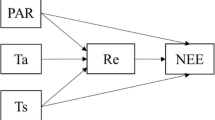Abstract
For modeling the distribution of plant species in terms of climate covariates, we consider an autologistic regression model for spatial binary data on a regularly spaced lattice. This model belongs to the class of autologistic models introduced by Besag (1974). Three estimation methods, the coding method, maximum pseudolikelihood method and Markov chain Monte Carlo method are studied and comparedvia simulation and real data examples. As examples, we use the proposed methodology to model the distributions of two plant species in the state of Florida.
Similar content being viewed by others
References
Arnold, B.C. and Strauss, D. (1991) Pseudolikelihood estimation: some examples. Sankhyã: The Indian Journal of Statistics, 53, B, 233–243.
Austin, M.P., Nicholls, A.O. and Margules, C.R. (1990) Measurement of the realized qualitative niche: environmental niches of five eucalyptus species. Ecological Monographs, 60 (2), 161–177.
Bartlein, P.J., Prentice, I.C. and Webb, T. (1986) Climatic response surfaces from pollen data for some eastern North American taxa. Journal of Biogeography, 13, 35–57.
Besag, J. (1972) Nearest-neighbour systems and the auto-logistic model for binary data (with Discussion). Journal of the Royal Statistical Society, Series B, 34, 75–83.
Besag, J. (1974) Spatial interaction and the statistical analysis of lattice systems (with Discussion). Journal of the Royal Statistical Society, Series B, 36, 192–236.
Besag, J. (1975) Statistical analysis of non-lattice data. The Statistician, 24, 179–195.
Besag, J. (1977) Efficiency of pseudolikelihood estimators for simple Gaussian fields. Biometrika, 64, 616–8.
Besag, J. and Moran, P.A.P. (1975) On the estimation and testing of spatial interaction in Gaussian Lattice Processes, Biometrika, 62, 555–562.
Box, E.O., Crumpacker, D.W. and Hardin E.D. (1993) A climatic model for location of plant species in Florida, U.S.A. Journal of Biogeography, 20, 629–44.
Chalmond, B. (1986) Image restoration using an estimated Markov model. Preprint, Mathematics Dept., University of Paris, Orsay.
Comets, F. (1992) On consistency of a class of estimators for exponential families of Markov random fields on the lattice. The Annals of Statistics, 20, (1), 455–568.
Cressie, N. (1993) Statistics for Spatial Data (revised edition). Wiley, New York.
Geman, S. and Geman, D. (1984) Stochastic relaxation, Gibbs distributions, and the Bayesian restoration of images. IEEE Transactions on Pattern Analysis and Machine Intelligence, 6, 721–41.
Geman, S. and Graffine, C. (1987) Markov random field image models and their applications to computer vision. Proceedings of the 1986 International Congress of Mathematicians, (A.M. Gleason, ed.) Vol. 2, pp. 1496–1517. American Mathematical Society, Providence, R.I.
Geyer, C.J. (1991) Markov chain Monte Carlo maximum likelihood. Computing Science and Statistics: Proceedings of the 23rd Symposium on the Interface (E.M. Keramides, ed.), pp. 156–63.
Geyer, C.J. (1992) Practical Markov chain Monte Carlo (with discussion). Statistical Science, 7, (4), 473–511.
Geyer, C.J. (1994) On the convergence of Monte Carlo maximum likelihood calculations. Journal of the Royal Statistical Society, Series B, 56, 261–74.
Geyer, C.J. and Thompson, E.A. (1992) Constrained Monte Carlo maximum likelihood for dependent data (with discussion). Journal of the Royal Statistical Society, Series B, 54 657–99.
Gidas, B. (1986) Consistency of maximum likelihood and pseudolikelihood estimators for Gibbs distributions. Proceedings of the Workshop on Stochastic Differential Systems with Applications in Electrical/Computer Engineering, Control Theory, and Operations Research, IMA, University of Minnesota. 129–45.
Gidas, B. (1991) Parameter estimation for Gibbs distributions from fully observed data. Markov Random Fields: Theory and Applications, (R. Chellappa and A. Jain, eds), Academic, New York. 471–98.
Huffer, F.W. and Wu, H. (1995) Markov chain Monte Carlo for autologistic regression models with applica-tion to the distribution of plant species, (submitted for publication).
Huntley, B., Bartlein, P.J. and Prentice, I.C. (1989) Climatic control of the distribution and abundance of beech (Fagus L.) in Europe and North America. Journal of Biogeography, 16, 551–60.
Jensen, J.L. and Mùoller, J. (1991) Pseudolikelihood for exponential family models of spatial point processes. The Annals of Applied Probability, 1, (3), 445–61.
Little, Jr., E.L. (1978) Atlas of United States Trees, Volume 5. Florida. Misc. Publ. No. 1361, USDA Forest Service. Washington, D.C.: U.S. Government Printing Office. 256 maps, with indices of common and scientific names.
Preisler, H.K. (1993) Modelling spatial patterns of trees attacked by bark beetles. Applied Statistics, 42, 501–14.
Ripley, B.D. (1988) Statistical Inference for Spatial Processes, Cambridge University Press, Cambridge.
Schwartz, M.W. (1988) Species diversity patterns in woody flora on three north American peninsulas. Journal of Biogeography, 15, 759–74.
Strauss, D. and Ikeda, M. (1990) Pseudolikelihood estimation for social networks. Journal of the American Statistical Association, 85, 204–12.
Winkler, G. (1995) Image Analysis, Random Fields and Dynamic Monte Carlo Methods: A Mathematical Introduction, Springer-Verlag, Berlin.
Wu, H. (1994) Regression models for spatial binary data with application to the distribution of plant species. Ph.D. Dissertation, Department of Statistics, The Florida State University.
Zhao, L.P. and Prentice, R.L. (1990) Correlated binary regression using a quadratic exponential model. Biometrika, 77, 642–48.
Author information
Authors and Affiliations
Rights and permissions
About this article
Cite this article
Wu, H., Huffer, F.R.W. Modelling the distribution of plant species using the autologistic regression model. Environmental and Ecological Statistics 4, 31–48 (1997). https://doi.org/10.1023/A:1018553807765
Issue Date:
DOI: https://doi.org/10.1023/A:1018553807765




